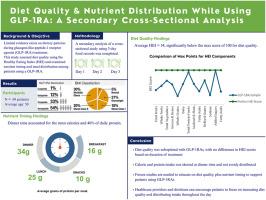Diet quality and nutrient distribution while using glucagon-like-peptide-1 receptor agonist: A secondary cross-sectional analysis
引用次数: 0
Abstract
Background
With the rise of glucagon-like-peptide-1 receptor agonist medications (GLP-1RA) for obesity treatment, understanding diet quality can be a valuable tool for providing evidence-based nutrition guidance. However, there is limited data on dietary intake during GLP-1RA treatment. Thus, we analyzed diet quality and nutrient timing while using GLP-1RA.
Methods
This was a secondary analysis from a previous cross-sectional online survey questionnaire study involving adults currently using GLP-1RA for weight reduction (N = 69, 49.6 ± 12.3 years old, 35.9 ± 9.1 kg/m2). Three-day food records were analyzed using the Healthy Eating Index (HEI), a validated score that indicates overall diet quality. The 13 HEI components were scored from average 3-day food records and calculated using 95 % confidence intervals (CI). A Bonferroni correction applied significance accepted at p = 0.0038. Additionally, 95 % CI were calculated for calories, macronutrients, and fiber intake reported for breakfast, lunch, dinner, and snacks.
Results
A 95 % CI revealed a total HEI score of 54 ± 12 (51.4, 57.3), significantly below the HEI goal (p < 0.0038). All components, except added sugars, were significantly under the max score. There was no significant difference for HEI scores based on duration of GLP-1RA use. The largest number of calories were consumed at dinner, averaging 649 compared to 538, 392, and 391 calories at lunch, breakfast, and snacks, respectively. Further, 40 % of the total daily protein intake occurred at dinnertime.
Conclusion
Within the sample of patients using GLP-1RAs, dietary quality was suboptimal for fruits, vegetables, whole grains, seafood and plant proteins, dairy and fatty acids. Future research is needed to determine if HEI scores change before, during, and after GLP-1RA treatments and nutrient timing.

使用胰高血糖素样肽-1受体激动剂时的饮食质量和营养分布:二次横断面分析
随着胰高血糖素样肽-1受体激动剂(GLP-1RA)药物用于肥胖治疗的兴起,了解饮食质量可能是提供循证营养指导的宝贵工具。然而,关于GLP-1RA治疗期间饮食摄入的数据有限。因此,我们在使用GLP-1RA时分析了饮食质量和营养时机。方法:这是先前一项横断面在线调查问卷研究的二次分析,该研究涉及目前使用GLP-1RA减肥的成年人(N = 69, 49.6±12.3岁,35.9±9.1 kg/m2)。三天的饮食记录分析使用健康饮食指数(HEI),一个有效的分数,表明整体饮食质量。13种HEI成分根据平均3天的食物记录进行评分,并使用95%置信区间(CI)计算。Bonferroni校正应用显著性接受p = 0.0038。此外,计算了早餐、午餐、晚餐和零食的卡路里、常量营养素和纤维摄入量的95%置信区间。结果95% CI显示HEI总分为54±12(51.4,57.3),明显低于HEI目标(p <;0.0038)。除添加糖外,其余组分均显著低于最高分数。基于GLP-1RA使用时间的HEI评分无显著差异。晚餐消耗的卡路里最多,平均为649卡路里,而午餐、早餐和零食分别为538、392和391卡路里。此外,每日总蛋白质摄入量的40%发生在晚餐时间。结论在使用GLP-1RAs的患者样本中,水果、蔬菜、全谷物、海鲜和植物蛋白、乳制品和脂肪酸的膳食质量较差。未来的研究需要确定HEI评分是否在GLP-1RA治疗和营养时机之前,期间和之后发生变化。
本文章由计算机程序翻译,如有差异,请以英文原文为准。
求助全文
约1分钟内获得全文
求助全文

 求助内容:
求助内容: 应助结果提醒方式:
应助结果提醒方式:


